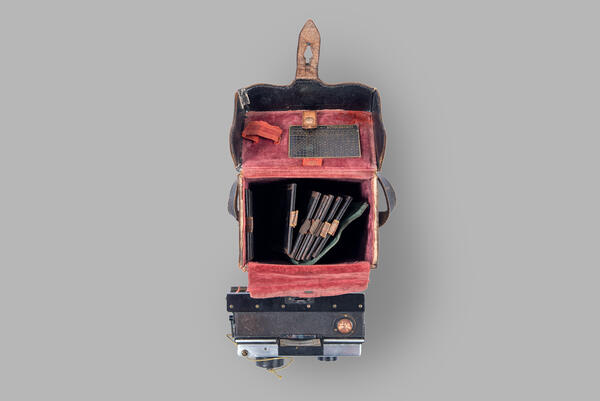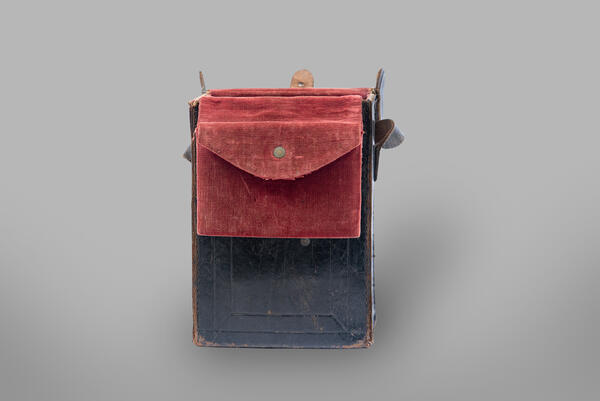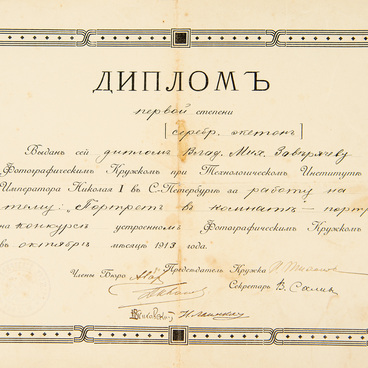The “Nil Melior” stereoscopic camera belonged to Vladimir Mikhailovich Zaveryachev, son of the manager of the Boratynskys’ estate. Vladimir was an amateur photographer. While studying at the Technological Institute of Emperor Nicholas I in Saint Petersburg, he joined its photographic society and was awarded diplomas for his photographic works.
In addition to the stereoscopic camera, the following accessories have survived: a carrying case, six cassettes for photographic plates, and a description of the machine in Russian.
Stereoscopy and photography are practically the same age. Stereoscopes first used drawings rather than photographs. The idea to combine stereoscopy and photography came to the Englishman David Brewster, inventor of the kaleidoscope, in 1844.
A stereoscopic pair is formed by two normal photographs of the same object, taken from two different points, with a distance of 6.5 to 20 cm between them. Initially, the pictures were taken with a regular camera of a small size, moved from right to left, or with two cameras. The optimum solution was the binocular camera, which was designed in 1860. Two lenses, positioned 6.5 cm apart, could be opened and closed at the same time with a connecting rod. This not only spared the photographer from having to manipulate the camera, but also made it possible to synchronize the shooting of a stereo pair and thus obtain stereographic images of moving objects.
Stereophotography has played a prominent role in the spread of photography. The phenomenon of amateur photography owes its popularity to stereophotography. The stereoscopic camera was easier to operate than a professional large-format camera, and far less expensive.
Stereophotography became a fashionable entertainment, an integral part of the salon culture of the second half of the 19th century. Stereoscopes of various designs were used for viewing — from a functional box or portable case to a miniature chest of drawers. Over time, a standard stereo pair format of 17.5×8.5 cm was established.
Many famous photographers of the 19th century succumbed to the craze for stereophotography. The technology of photography and printing changed, but stereophotography remained invariably popular until the beginning of the 20th century. Then it was replaced by another type of visual representation — a more sophisticated technology — cinematography.
In addition to the stereoscopic camera, the following accessories have survived: a carrying case, six cassettes for photographic plates, and a description of the machine in Russian.
Stereoscopy and photography are practically the same age. Stereoscopes first used drawings rather than photographs. The idea to combine stereoscopy and photography came to the Englishman David Brewster, inventor of the kaleidoscope, in 1844.
A stereoscopic pair is formed by two normal photographs of the same object, taken from two different points, with a distance of 6.5 to 20 cm between them. Initially, the pictures were taken with a regular camera of a small size, moved from right to left, or with two cameras. The optimum solution was the binocular camera, which was designed in 1860. Two lenses, positioned 6.5 cm apart, could be opened and closed at the same time with a connecting rod. This not only spared the photographer from having to manipulate the camera, but also made it possible to synchronize the shooting of a stereo pair and thus obtain stereographic images of moving objects.
Stereophotography has played a prominent role in the spread of photography. The phenomenon of amateur photography owes its popularity to stereophotography. The stereoscopic camera was easier to operate than a professional large-format camera, and far less expensive.
Stereophotography became a fashionable entertainment, an integral part of the salon culture of the second half of the 19th century. Stereoscopes of various designs were used for viewing — from a functional box or portable case to a miniature chest of drawers. Over time, a standard stereo pair format of 17.5×8.5 cm was established.
Many famous photographers of the 19th century succumbed to the craze for stereophotography. The technology of photography and printing changed, but stereophotography remained invariably popular until the beginning of the 20th century. Then it was replaced by another type of visual representation — a more sophisticated technology — cinematography.





